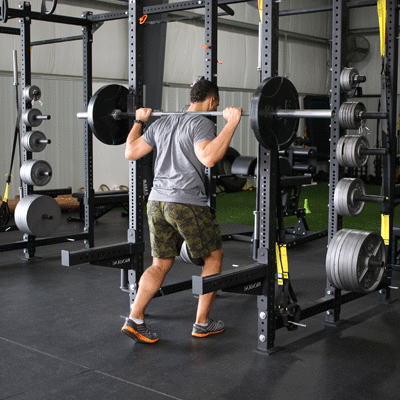Benefits of Squats, Variations, and Muscles Worked
7 Benefits of Doing Squats and Variations to Try
When performed correctly, squats are a functional exercise that can boost your calorie burn, help prevent injuries, strengthen your core, and improve your balance and posture.
The squat is a fundamental movement pattern that requires multiple joint and muscle integration. Babies squat perfectly. And then we unlearn this in favor of bending over.
As a dynamic strength training exercise, squats require several muscles in your upper and lower body to work together simultaneously.
Many of these muscles help power you through daily tasks such as walking, climbing stairs, bending, or carrying heavy loads. They also help you perform athletic-related activities.
Adding squats to your workouts can help boost your exercise performance, decrease your risk of injury, and keep you moving more easily throughout the day. But these are just a few of the benefits.
Keep reading to learn more about the rewards you can reap from doing squats and variations you can try for added benefits.
When performed correctly, squats are a functional exercise that can boost your calorie burn, help prevent injuries, strengthen your core, and improve your balance and posture.
The squat is a fundamental movement pattern that requires multiple joint and muscle integration. Babies squat perfectly. And then we unlearn this in favor of bending over.
As a dynamic strength training exercise, squats require several muscles in your upper and lower body to work together simultaneously.
Many of these muscles help power you through daily tasks such as walking, climbing stairs, bending, or carrying heavy loads. They also help you perform athletic-related activities.
Adding squats to your workouts can help boost your exercise performance, decrease your risk of injury, and keep you moving more easily throughout the day. But these are just a few of the benefits.
Keep reading to learn more about the rewards you can reap from doing squats and variations you can try for added benefits.
If there’s one exercise that has the ability to challenge most of the muscles in your body, it’s the squat.
The obvious muscles targeted are in the lower body, but in order to do this compound exercise correctly, you also need to use several muscles above your waist.
The lower muscles targeted in a squat include your:
- gluteus maximus, minimus, and medius (buttocks)
- quadriceps (front of the thigh)
- hamstrings (back of the thigh)
- adductor (groin)
- hip flexors
- calves
In addition to the lower body, the squat also targets your core muscles. These muscles include the rectus abdominis, obliques, transverse abdominis, and erector spinae.
If you do a back squat or overhead squat, you’ll also work the muscles in your shoulders, arms, chest, and back.
If there’s one exercise that has the ability to challenge most of the muscles in your body, it’s the squat.
The obvious muscles targeted are in the lower body, but in order to do this compound exercise correctly, you also need to use several muscles above your waist.
The lower muscles targeted in a squat include your:
- gluteus maximus, minimus, and medius (buttocks)
- quadriceps (front of the thigh)
- hamstrings (back of the thigh)
- adductor (groin)
- hip flexors
- calves
In addition to the lower body, the squat also targets your core muscles. These muscles include the rectus abdominis, obliques, transverse abdominis, and erector spinae.
If you do a back squat or overhead squat, you’ll also work the muscles in your shoulders, arms, chest, and back.
Known as a bodyweight squat or an air squat, the most basic type of squat uses just your body weight for resistance. Variations of the squat can include weights, like barbells or dumbbells, resistance bands, or yoga balls.
Ideally, it’s a good idea to work with a trainer to help you with your form when learning a squat. When you begin, the pressure in the squat should be placed almost evenly through your feet. Sometimes this is called foot tripod.
Imagine a triangle on the sole of your foot, with pressure placed equally in three areas: on the front of the foot right behind the big toe, on the front of the foot behind the pinky toe, and on the heel.
To do a basic squat:
- Start with feet slightly wider than hip-width apart, toes turned slightly out.
- Keeping your chest up and out and the pressure even in your feet, engage your abdominals and shift your weight back into your heels as you push your hips back.
- Lower yourself into a squat until either your heels begin to lift off the floor, or until your torso begins to round or flex forward. Your depth should be determined by your form.
- Keep your chest out and core tight as you push through your heels to stand back up to your starting position. Squeeze your glutes at the top.
- Perform 10–15 reps. Work up to 3 sets.
Known as a bodyweight squat or an air squat, the most basic type of squat uses just your body weight for resistance. Variations of the squat can include weights, like barbells or dumbbells, resistance bands, or yoga balls.
Ideally, it’s a good idea to work with a trainer to help you with your form when learning a squat. When you begin, the pressure in the squat should be placed almost evenly through your feet. Sometimes this is called foot tripod.
Imagine a triangle on the sole of your foot, with pressure placed equally in three areas: on the front of the foot right behind the big toe, on the front of the foot behind the pinky toe, and on the heel.
To do a basic squat:
- Start with feet slightly wider than hip-width apart, toes turned slightly out.
- Keeping your chest up and out and the pressure even in your feet, engage your abdominals and shift your weight back into your heels as you push your hips back.
- Lower yourself into a squat until either your heels begin to lift off the floor, or until your torso begins to round or flex forward. Your depth should be determined by your form.
- Keep your chest out and core tight as you push through your heels to stand back up to your starting position. Squeeze your glutes at the top.
- Perform 10–15 reps. Work up to 3 sets.
The list of squat benefits is lengthy, but to summarize and point out the top picks, here are seven key benefits of doing squats.
The list of squat benefits is lengthy, but to summarize and point out the top picks, here are seven key benefits of doing squats.
1. Strengthens your core
Having strong core muscles can make everyday movements like turning, bending, and even standing easier. Not only that, but a strong core can improve your balance, ease pain in your low back, and also make it easier to maintain good posture.
A 2018 study that compared core muscle activation during a plank with back squats found that back squats resulted in greater activation of the muscles that support your back.
Based on these findings, the researchers recommended targeting the core muscles with back squats to reduce the risk of injury and to boost athletic performance.
Having strong core muscles can make everyday movements like turning, bending, and even standing easier. Not only that, but a strong core can improve your balance, ease pain in your low back, and also make it easier to maintain good posture.
A
Based on these findings, the researchers recommended targeting the core muscles with back squats to reduce the risk of injury and to boost athletic performance.
2. Reduces the risk of injury
When you strengthen the muscles in your lower body, you’re better able to execute full-body movements with correct form, balance, mobility, and posture.
Plus, incorporating squats in your overall workout routine also helps strengthen your tendons, ligaments, and bones, which, according to the American Council on Exercise, may help reduce your risk of injury.
When you strengthen the muscles in your lower body, you’re better able to execute full-body movements with correct form, balance, mobility, and posture.
Plus, incorporating squats in your overall workout routine also helps strengthen your tendons, ligaments, and bones, which, according to the American Council on Exercise, may help reduce your risk of injury.
3. Crushes calories
Calorie burning is often equated with aerobic exercises such as running or cycling. But performing high-intensity, compound movements like the squat can also crush some serious calories.
For example, according to Harvard Medical School, a 155-pound person can burn approximately 223 calories doing 30-minutes of vigorous strength or weight training exercises, like squats.
Calorie burning is often equated with aerobic exercises such as running or cycling. But performing high-intensity, compound movements like the squat can also crush some serious calories.
For example, according to Harvard Medical School, a 155-pound person can burn approximately 223 calories doing 30-minutes of vigorous strength or weight training exercises, like squats.
4. Strengthens the muscles of your lower body
Your lower body boasts some of your largest and most powerful muscles.
From getting out of bed, to sitting down in a chair, your glutes, quadriceps, hamstrings, adductors, hip flexors, and calves are responsible for almost every move you make.
Strength training exercises like squats can help strengthen and tone the muscles in your lower body. When these muscles are in good condition, you may find that you can move more comfortably, with less pain, and that everything from walking to bending to exercising is easier to do.
Your lower body boasts some of your largest and most powerful muscles.
From getting out of bed, to sitting down in a chair, your glutes, quadriceps, hamstrings, adductors, hip flexors, and calves are responsible for almost every move you make.
Strength training exercises like squats can help strengthen and tone the muscles in your lower body. When these muscles are in good condition, you may find that you can move more comfortably, with less pain, and that everything from walking to bending to exercising is easier to do.
5. Boosts athletic ability and strength
If you compete in a sport, adding jump squats to your workout may help you develop explosive strength and speed which, in turn, may help improve your athletic performance.
A 2016 study investigated the effects of jump squat training done 3 times a week over the course of 8 weeks.
Based on the results of the study, the researchers concluded that jump squat training has the ability to improve several different athletic performances simultaneously, including sprint time and explosive strength.
If you compete in a sport, adding jump squats to your workout may help you develop explosive strength and speed which, in turn, may help improve your athletic performance.
A
Based on the results of the study, the researchers concluded that jump squat training has the ability to improve several different athletic performances simultaneously, including sprint time and explosive strength.
6. Variety helps with motivation
Once you master the basic squat, there are many different types of squat variations you can try. Changing up your squats can help keep the exercise interesting, while also activating different muscle groups.
Squats can be done with just your body weight. They can also be done with weights, like dumbbells, barbells, kettlebells, or medicine balls, or with resistance bands or yoga balls.
Once you master the basic squat, there are many different types of squat variations you can try. Changing up your squats can help keep the exercise interesting, while also activating different muscle groups.
Squats can be done with just your body weight. They can also be done with weights, like dumbbells, barbells, kettlebells, or medicine balls, or with resistance bands or yoga balls.
7. Can be done anywhere
To do bodyweight squats, you don’t need any equipment. All you need is your body and enough room to lower your hips into a sitting position.
And, if you’re pressed for time, you can still benefit many muscle groups by doing 50 squats a day: Try doing 25 in the morning and 25 at night. As you get stronger, add 25 to the afternoon.
To do bodyweight squats, you don’t need any equipment. All you need is your body and enough room to lower your hips into a sitting position.
And, if you’re pressed for time, you can still benefit many muscle groups by doing 50 squats a day: Try doing 25 in the morning and 25 at night. As you get stronger, add 25 to the afternoon.
Changing up the basic squat allows you to target different muscle groups. It also helps with motivation so you don’t get bored with performing the same move repeatedly.
Before moving on to squat variations, make sure you have mastered the basic squat movement. These exercises are more challenging and require more strength, flexibility, and core activation.
Changing up the basic squat allows you to target different muscle groups. It also helps with motivation so you don’t get bored with performing the same move repeatedly.
Before moving on to squat variations, make sure you have mastered the basic squat movement. These exercises are more challenging and require more strength, flexibility, and core activation.
The back squat takes the traditional squat motion and adds resistance to the shoulders with a barbell. It’s often considered the “gold standard” when it comes to enhancing athletic performance , as it requires the coordinated interaction of numerous muscle groups.
The back squat places an emphasis on the glutes and hips while still targeting the quads.
- Set a barbell in a squat rack, just below shoulder height.
- Move underneath the bar so it’s resting behind your neck across the top of your back. Grip the bar with your hands.
- With your feet a little wider than shoulder-width apart, step back so you can clear the rack.
- Lower yourself into a squat so your hips are below your knees.
- Pause briefly, then press through your feet and push your hips back up to the starting position.
The back squat takes the traditional squat motion and adds resistance to the shoulders with a barbell. It’s often considered the “gold standard” when it comes to
The back squat places an emphasis on the glutes and hips while still targeting the quads.
- Set a barbell in a squat rack, just below shoulder height.
- Move underneath the bar so it’s resting behind your neck across the top of your back. Grip the bar with your hands.
- With your feet a little wider than shoulder-width apart, step back so you can clear the rack.
- Lower yourself into a squat so your hips are below your knees.
- Pause briefly, then press through your feet and push your hips back up to the starting position.
This movement is relatively easy for most people to perform, so here are some more challenging positions to try.
It’s also a doctor’s favourite exercise prescription for older patients as it will help strengthen the knees and hips, which is important for balance and avoiding falls.
As we age, our soft tissues become less elastic; doing squats regularly can help slow down the process and keep you limber for longer.
The movement strengthens the tendons, ligaments and bones around the leg muscles, taking some load off the knees and ankles.
Loading your bones during squats can signal the body to increase the mineralisation of your bones.
It also turns on key hormones that build bone, rather than break it down.
Bone density is particularly important as we get older, so it’s certainly worth focusing on squats to delay bone loss.
Besides, squats tone your legs and booty, which then makes them firmer and improves your balance and posture.
When you walk tall and stand proud, all eyes are on you!
Most people are familiar with parallel squats, although half are probably doing it incorrectly, resulting in knee and back pain – many have complained to me about this.
When pain sets in, they give up on the exercise.
Performing a squat using the correct technique requires a good combination of mobility and strength.
The two most important muscles used in squats are the quadriceps (front of thighs) and gluteals (buttocks).
These muscles have to be able to lower the body slowly when going down, and be able to push you when you want to go back up.
The body sees this as two different muscle actions and an individual has to be able to perform both in order to have a successful squat.
Some people can go down easily, but can’t come back up, while others struggle to go down.
When you start off, how low you go should not be the emphasis.
Rather, concentrate on keeping the right form and go only as low as you can.
As your hip, knee and ankle mobility and strength get better, you should be able to go lower.
How to do a basic squat:
> Stand straight with feet hipwidth apart and toes pointing forward.
> Engage your stomach muscles. > Imagine you’re going to sit on a chair; push your hips back and lower yourself down.
> Keep your back straight and chest up as your arms come forward in front of your body to balance yourself.
> Go as low as you can, but the lowest should only be when your thighs are parallel to the floor and your knees are bent at 90°.
> Press through your heels and return to the starting position. For those who are already doing squats regularly, consider changing the way you do them to stimulate the same muscles in different ways.
Try some of the variations seen here to challenge yourself.
Again, keep in mind that a sharp pain or feeling pins and needles in any part of the body while doing the exercise is a clear sign that something is wrong – stop immediately.
Adjust your body and try again, or engage a personal trainer to correct your form.
Choose one variation, stick to 10-12 repetitions and two or three sets, depending on your ability.
If the pain persists, consult a healthcare professional.
Revathi Murugappan is a certified fitness trainer who tries to battle gravity and continues to dance to express herself artistically and nourish her soul. For more information, email starhealth@thestar. com.my. The information contained in this column is for general educational purposes only. Neither The Star nor the author gives any warranty on accuracy, completeness, functionality, usefulness or other assurances as to such information. The Star and the author disclaim all responsibility for any losses, damage to property or personal injury suffered directly or indirectly from reliance on such information.
45 Squat Variations to Keep You on Your Toes
We include products we think are useful for our readers. If you buy through links on this page, we may earn a small commission. Here’s our process.
Whether you love or loathe them, squats work. They’re beneficial not only for your legs and glutes, but also your core. Plus, they’re a functional exercise, meaning they can help make everyday activities easier.
And while there’s no denying the effectiveness of a basic squat, there are plenty more where that came from. Below, we’ve got 45 variations to help you up your squat game and keep things interesting.
These squats don’t require any equipment or added resistance — just your body weight.
1. Basic squat
This is the holy grail of squatting. Master this foundational move and you’ll be in great shape as you work your way through this list.
- Start with your feet shoulder-width apart, toes slightly out, and your arms down at your side.
- Start to hinge at the hips and bend your knees, sitting back like you’re going to sit down and allowing your arms to raise up in front of you. Ensure that your knees don’t fall inward and your back stays straight.
- When your thighs are parallel to the ground, stop and push up through your heels to return to start.
2. Wall squat
If you have knee or hip problems, a wall squat will provide extra support.
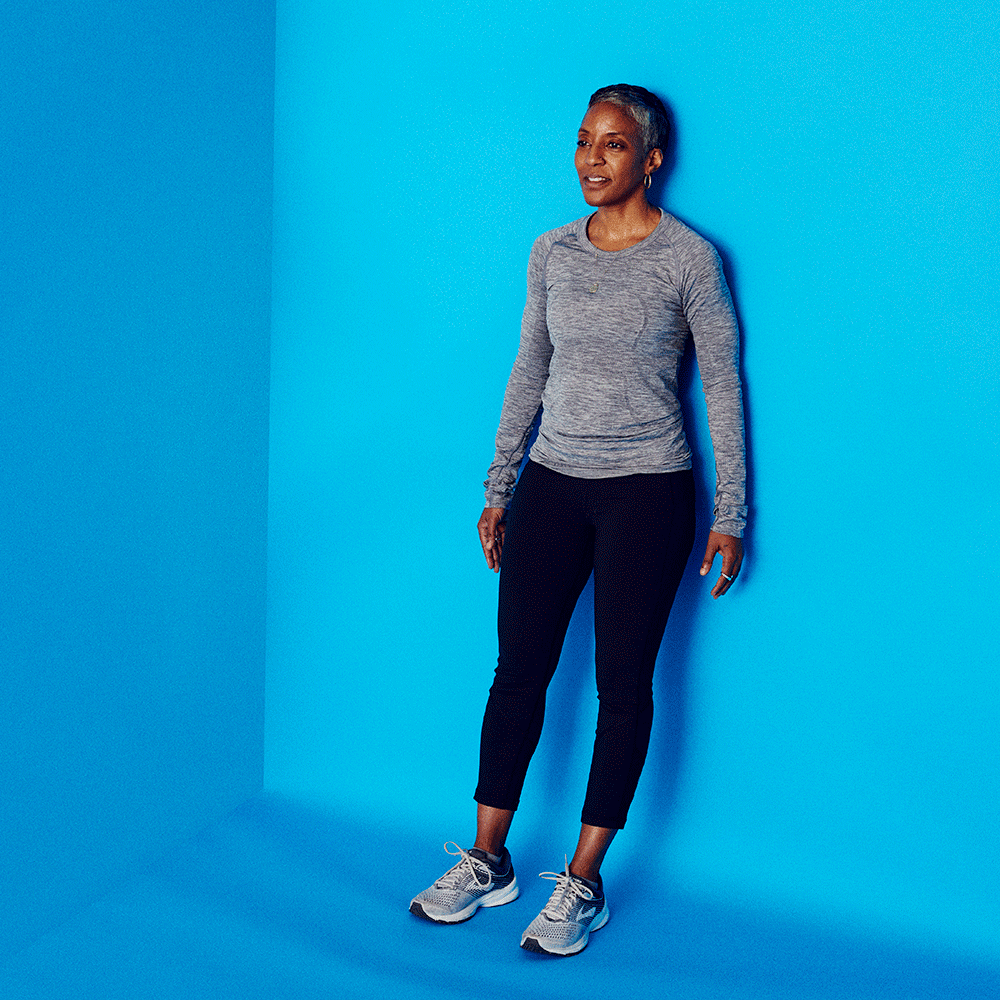
- Stand with your back against a wall and step your feet out about 12 inches from the wall.
- Bend your knees, dropping into a squat while keeping your back pinned to the wall throughout the movement.
- Stop when your thighs are parallel to the ground. Push up through your heels back to start.
3. Prisoner squat
Putting your hands behind your head helps to stabilize your core and shoulders.
- Start with your feet shoulder-width apart, toes slightly out, arms bent, and fingers interlaced behind your head.
- Proceed with a basic squat.
4. Side squat
It’s important to work in all planes of motion while exercising — that means not only front and back, but side to side as well.
- Start with your feet shoulder-width apart and your arms down at your sides.
- Begin to hinge at the hips and bend your knees, stepping your right foot out to the side and allowing your arms to raise up in front of you to a comfortable position.
- When your thighs are parallel to the ground, stand up, stepping your left foot to meet your right.
- Repeat, stepping your left foot out and bringing your right foot to meet it.
5. Pistol squat
A more advanced move, a pistol squat is a single-leg bodyweight squat that requires strength, balance, and mobility.
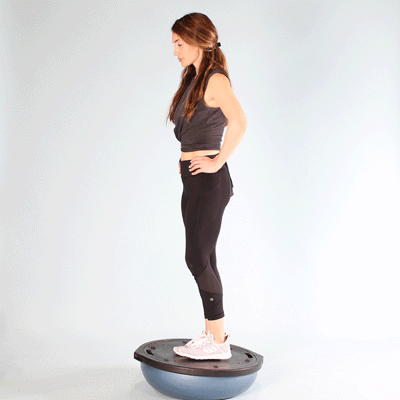
- Start standing with your feet together and extend your arms out in front of you.
- Lift your left leg up off of the floor in front of you and squat down on your right, lowering until your left leg is parallel to the floor.
- Stand up and repeat on the other side.
6. Single-leg squat
Not to be confused with a pistol squat, a single-leg squat is just that — a squat on one leg. The main difference is that in a single-leg squat, the free leg doesn’t have to be parallel to the ground.
- Start by standing with your feet together and your arms out in front of you.
- Lift your left leg up off of the ground in front of you and squat down on your right as far as you can go, stopping when your right thigh is parallel to the ground.
- Stand up, then switch legs.
7. Plié squat
Channel your inner ballet star with a plié squat. It’s great for targeting your hips, too.
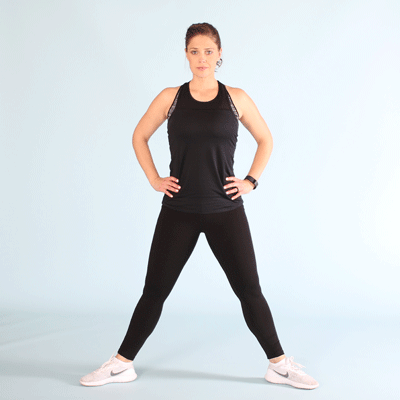
- Start with your feet wider than shoulder-width apart, toes pointed out.
- Bend your knees, dropping until your thighs are parallel to the ground, or as far as you can go. Keep your chest up throughout the movement.
- Push through your heels to return to start.
8. Plié squat with foot drag
- Start by doing a plié squat. As you come back up, drag your right foot on the ground to meet your left leg.
- Step your left foot out wide, plié squat, then drag your left foot to meet your right.
9. Squat with knee drive
- Drop down into a basic squat.
- As you come up, drive your right knee up as high as it will go.
- Drop immediately down again to another basic squat, pushing up and driving your left knee up this time.
10. Side-kick squat
Adding a kick to your squats takes them from strength to cardio in no time.
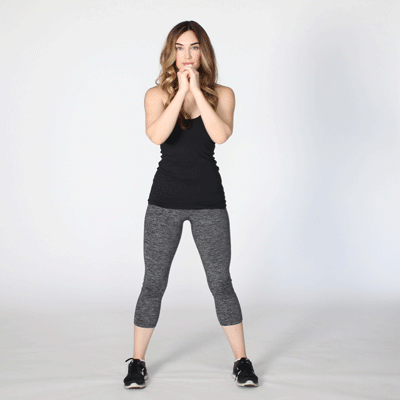
- Drop down into a basic squat.
- As you come up, kick your right leg up as high as it will go.
- Drop immediately down again to another basic squat, pushing up and kicking your left leg up.
11. Split squat

- Stagger your stance so your right foot is in front of your left.
- Perform a squat, dropping down until your right thigh is parallel to the ground.
- Stand and switch your stance.
12. Close-stance squat
Bringing your feet closer together gives your quads an extra workout.
- Start standing with your feet in a close stance, toes pointed straight ahead.
- Hinge at your hips and sit back into a squat, ensuring that your knees don’t cave in. Stand up when your thighs are parallel to the ground.
13. Lateral squat walk
- Complete a side squat, but instead of stepping back to center, continue moving in one direction.
- Repeat the same number of steps on the other side.
14. Curtsy squat
This variation gives some extra attention to your glutes.
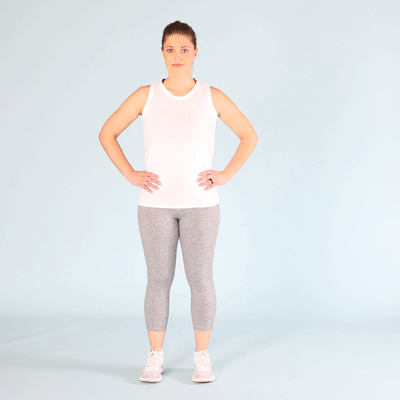
- Start with your feet shoulder-width apart, hands on your hips.
- Step your right leg back, crossing it behind your left, like you’re curtsying, bending your left leg and stopping when your thigh is parallel to the ground.
- Return to start and complete with your opposite leg.
15. Squat walk
Feel the burn with a squat walk, which increases time under tension — or the length of time is muscle is working.
- Drop down into a basic squat.
- Without coming up, walk one foot in front of the other.
16. Frog squats
- Drop down into a basic squat.
- Place your elbows inside your knees, clasping your hands together.
- Keeping your elbows where they are, slowly start to straighten your legs, pushing your hips up in the air, then lower back down.
17. Squat pulse
- Drop down into a basic squat.
- Instead of fully extending back up to the start, rise up halfway, then drop back down again.
18. Squat jacks
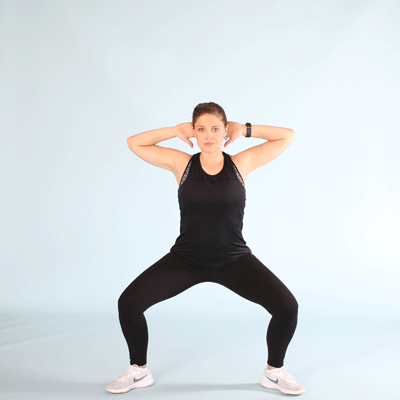
- Drop down into a basic squat with your arms behind your head.
- Jump your feet out and back in, maintaining a squat position.
19. Squat with kickback
- Drop down into a basic squat.
- As you come up, lift your right foot off of the ground, squeezing your glute and kicking your leg back behind you. Ensure that your hips stay square to the ground.
- Lower your foot back to the ground, squat down again, and kick your left leg behind.
By adding dumbbells, a barbell, or a kettlebell to your squats, you’ll challenge yourself with more resistance.
20. Overhead squat
An overhead squat, with a weight held above your head, requires more stability, mobility, and flexibility than a basic squat.
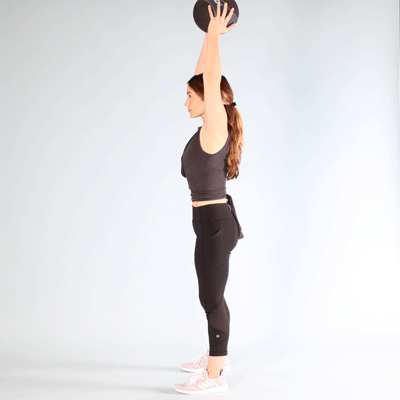
- Stand with your feet wider than shoulder-width apart, toes pointed out. Hold a barbell or ball over your head with a wide grip.
- Keeping your chest and head up, sit back into your hips, letting your thighs go just past parallel to the ground.
- Drive through your heels to return to start.
21. Landmine squat
This variation uses a landmine machine, which you can find in many gyms.
- Put the bar into a corner or a landmine station and load it with the desired amount of weight.
- Stand in front of the weighted end, holding it with both hands at chest level, and squat down.
- Push up through your heels, keeping your chest up throughout.
22. Barbell back squats
- Load a barbell onto your shoulders.
- Complete a basic squat.
23. Dumbbell squat
- Hold a dumbbell in each hand at your sides and complete a basic squat.
- Keep your chest open and your head up.
24. Front squat
Because you’re holding a weight in front of you for this variation, your core goes into overdrive. Your upper back must work to maintain good posture and your quads experience a higher load.
- Load a barbell onto your front side, resting it on the front of your shoulders, crossing your arms, and gripping the bar.
- Drop down into a basic squat.
25. Goblet squat
Similar to a front squat, your anterior chain — or the front of your body — is doing most of the work in a goblet squat. The bottom position is also pretty natural and easy for most people to achieve.
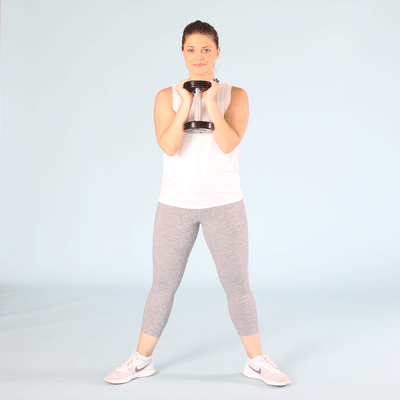
- Hold a dumbbell or kettlebell close to your chest with your feet slightly wider than shoulder-width apart and toes pointed slightly out.
- Keeping your chest and head up, bend your knees until your hamstrings touch your calves. Stand up.
26. Zercher squat
Another front-loaded squat, the Zercher squat isn’t for the faint of heart, as it requires holding the weight in the crook of your elbow.
- Hold the barbell in the crook of your elbow with your palms facing you.
- Drop down into a basic squat.
27. Bulgarian split squat
This single-leg variation forces you to really engage your core. Complete this move by holding a dumbbell in each hand or loading a barbell on your back.
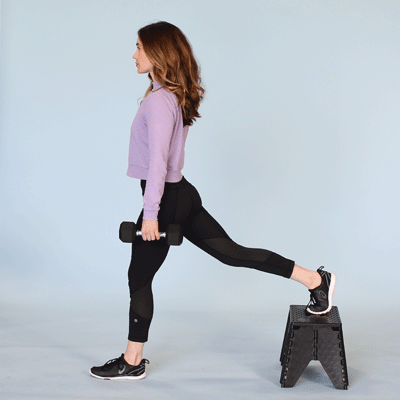
- Position yourself in front of a bench with a split stance, resting your left foot up on the bench. Your right foot should be far enough out to comfortably squat down without your knee falling over your toes.
- Keeping your chest open, squat down on your right leg, pushing back up through your heel.
- Stand up and perform on the other side.
Plyometric squats involve explosive movements that require your muscles to exert maximum force in a very short amount of time — they combine speed with strength to make you more powerful.
CAUTIONIf you’re new to working out or have any kind of injury, hold off on these moves, which can be rough on your joints.
28. Jump squat
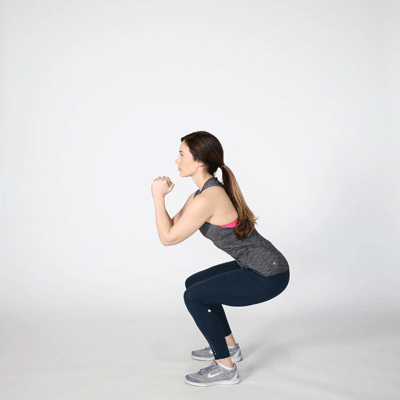
- Assume a basic squat position. Drop down, and on the way up, explode up through your toes into a jump.
- Land softly, immediately dropping back down and exploding back up again.
29. Jump squat on toes
This variation is a little easier on your knees and ankles.
- Assume a jump squat position.
- Instead of leaving the ground on the up, just rise up onto your toes.
30. Weighted jump squat
- Hold a light dumbbell in both hands.
- Complete a standard jump squat.
31. Pop squat
- Start with your feet together and your arms at your side.
- Bend your knees and bring your arms in front of you, bending at the elbow.
- Rise and “pop” up, landing your feet out wide, allowing a slight bend in your knee, then immediately jumping back to the middle with your feet.
- Rise and pop up again.
Benches, boxes, yoga balls, and bands — they can all help you perfect your form while giving you some added resistance.
32. Wall squat on yoga ball
- Do a wall squat, but place an exercise ball between you and the wall.
- Roll down the ball as you lower your body.
33. Box or bench squat
If you’re new to squats, a bench squat is a good way to push yourself a little lower.
- Position yourself in front of a bench or a box so you touch it lightly when you sit down into a squat.
- Do a basic squat, lowering until your bottom touches the seat, then stand back up.
34. Mini band squat
Proper squat form entails keeping your knees out, but it’s common to see knees caving in, which can be a sign of weak glutes.
Using a mini band, which you can find online, forces you to avoid this mistake.
- Place a mini band above your knees, assuming the stance for a basic squat.
- Execute a basic squat, ensuring that you’re pushing your thighs out against the bands.
35. Sissy squat
You can do a version of a sissy squat just using a plate, but it’ll be easier with a sissy squat machine — that’s what we’ll explain here.
- Position yourself in the sissy squat machine so you’re standing with your calves against the large pad and your feet underneath the foot-stop pads.
- Begin to sit back, pushing against the restraint pads, until your thighs are parallel to the ground.
- Stand back up and repeat.
36. Resistance band squat
Resistance bands put less pressure on joints than weights do while still providing the tension you need to build strength.
You can find resistance bands of all types — and colors — online.
- Stand with both of your feed on the band, holding the ends at your waist.
- Keeping your hands where they are, stand up. Perform a basic squat.
- Stand up to return to start.
37. TRX squat
TRX straps, available online, use gravity and your own body weight to provide resistance training. A TRX squat is a great starter movement.
- Grab the TRX handles and hold them at chest level with extended arms, backing up until the straps are taut.
- Lower down into a squat, pulling just slightly against the straps.
38. TRX squat kick
- Set up for a standard TRX squat.
- As you come up, kick your right leg up and out.
- When your foot comes back to the ground, squat immediately down again, this time kicking your left leg up and out.
39. TRX squat jump
- Set up for a standard TRX squat.
- As you come up, explode into a jump, landing softly and immediately lowering back into a squat.
40. TRX pistol squat
Pistol squats can be quite challenging, but performing them with the help of a TRX strap can help you get the hang of things.
- Grab the TRX handles and hold them at chest level with extended arms, backing up until the straps are taut.
- Lift your left leg off of the ground, holding it straight in front of you, and squat on your right leg, allowing the left leg to reach parallel to the ground.
- Stand up and repeat with the other leg.
41. Smith machine squat
Also known as the assisted squat machine, Smith machine squats allow you to focus on form and reduce your risk of injury.
- Load the desired amount of weight onto the machine and position the bar so you can comfortably get underneath it and stand up. It should be resting across your traps and shoulders.
- Hinge at the hips and bend your knees, sitting back into your hips until your thighs are parallel to the floor.
- Stand up and repeat.
42. Hack squat
This variation uses a different machine called a hack machine.
- Load the desired amount of weight and position your back and shoulders against the pads and extend your legs, releasing the safety handles.
- Bend your knees, stopping when your thighs are parallel to the ground, and push back up to start.
43. Bosu squat
Using a Bosu ball, which you can find online, is a great way to work on your balance while you squat.
- Mount the Bosu ball so your feet are shoulder-width apart.
- Extend your arms out in front of you and bend your knees, sitting back into your hips and maintaining your balance. Keep your back straight throughout.
- Stand back up and repeat.
44. Reverse Bosu squat
This variation offers an even bigger balance challenge than the regular Bosu squat.
- Flip the Bosu ball so the flat surface is facing up. Carefully mount it so your feet flank the edges.
- Squat down, ensuring that your knees push outward, your chest is proud, back is straight and your head stays up.
- Push back up to start and repeat.
45. Box jump to squat
This is an advanced plyometric move involving a box. Take caution if you’ve never done a box jump before.
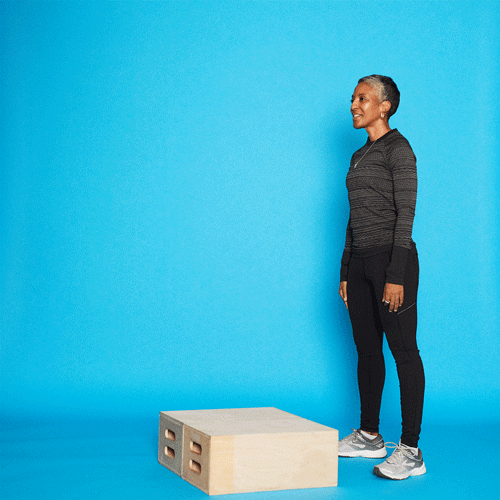
- Position yourself in front of a box.
- Drop down and jump up, landing on the box and dropping into a squat.
- Step off and repeat.

.webp)


